Prologue
I ran
away when I was ten. Things were fine at home, fantastic really.
I had all that an American boy could want, but that day I must
have grown weary with the clutter of toys and wondered where I
would go if I ever did need to clear out. I hopped on the
sparkly banana seat of my green Schwinn and pedaled down River
Drive to where Grant Street crossed the Delaware and Raritan
Canal and our little town met the highway. There was only one
problem: I wasn't allowed to cross this two-lane road. Where the
street intersected with Route 29 was particularly dangerous. A
blind curve hid the Trenton-bound traffic. This runaway had a
respect for ground rules . . .
Walking to School
Kids
wake to their own energy. They shift from restful sleep to
screaming run in seconds flat. No caffeine required. If we were
surviving off the land in some faraway jungle, they
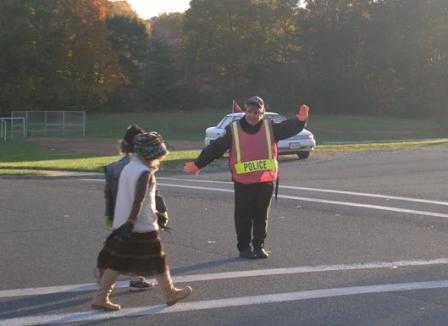 might
as well shout, "I am food!" As their parent, I rise too and make
sure the coast is clear, and that they have nourishment to start
the day . . .
might
as well shout, "I am food!" As their parent, I rise too and make
sure the coast is clear, and that they have nourishment to start
the day . . .
The
Places I've Lived, and the Ones I Live For
Before
I accepted a job teaching English in southwestern Virginia in
1998, we lived in a "carriage house," caretakers of a family
estate in the outermost suburbs of Cleveland, Ohio. We resided
in the village of Gates Mills, an official bird sanctuary, on a
plain above the ravines that feed the Chagrin River. Across the
street was the 389-acre Squire Vallevue Farm, a green leafy
outpost nestled between the gridded streets of the suburbs and
the windy trails of the metroparks, the "emerald necklace" of
Cleveland. We lived there three years. At present we are
sojourners in another place . . .
Beautiful Scavengers
The vultures have come back. They swirl and mix abov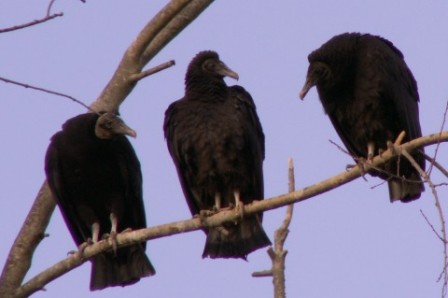 e
me as I ride my bike home on Sundell Drive, though not much
sun reaches this shady street and there are no farmers in
this dell. Only vultures. And deer. And skunks and raccoons
and other animals unwelcome in town . . .
e
me as I ride my bike home on Sundell Drive, though not much
sun reaches this shady street and there are no farmers in
this dell. Only vultures. And deer. And skunks and raccoons
and other animals unwelcome in town . . .
Scorched Earth
"We
are leaving in twenty minutes," I announce, making clear our
intentions to get out this winter Saturday on a hike. I must
declare our time of departure early so as not to spring it on
the children or surprise them, even though they know this moment
is coming. Earlier in the morning I had asked if they wanted to
go on a hike today, and the kids agreed but didn't want to leave
anytime soon. They first wanted to play and have the morning to
themselves. I try to justify why leaving early is a good idea,
but my argument has no effect . . .
Nordic Fun
All
week it had been near 60 degrees with rain, downright depressing
weather for skiers. But the snow report at the Whitegrass
Touring Center website is positive. "Still snow on the ground,"
owner-optimist Chip Chase reports, "and more on the way." We
leave before dawn on Saturday morning but are dubious. It
continues to rain as we head north and west, but when we cross
one final, ropy pass, 3,500-foot Allegheny Mountain in West
Virginia, rain changes to sleet . . .
Skating Pond
The
essay that was supposed to go here won't. Since getting kids out
during winter can be most difficult, I wanted to chronicle our
attempts to find a skating pond. We were going to find the right
one, learn how to test the ice, and feel our way on skates. From
the car, I had marked several nearby ponds to try when winter
came, and I knew of a good, still spot on the Little River. We
would bundle up in the late afternoon, build a small fire at
pond's edge, and bring a thermos of hot chocolate. But the
weather the past two winters has been too warm for ice-skating .
. .
Weed Eaters
I ate
my lawn this year. I also ate its roots. Probably a little dirt
too. It was the first of April but no foolin'. We added
dandelion and Pennsylvania bittercress to the greens that
over-wintered in our glass-covered cold frame and ate them with
a side of boiled yucca root. My daughter asked for more. Neither
kid said yuck. Not even once. It was the ultimate economy: what
would be discarded was on our dinner plate. . .
Creek Walking
We
call them streams, rivulets, branches, and brooks. In spring
they can be freshets. They are tributaries until you get to
either end. This one is a run.
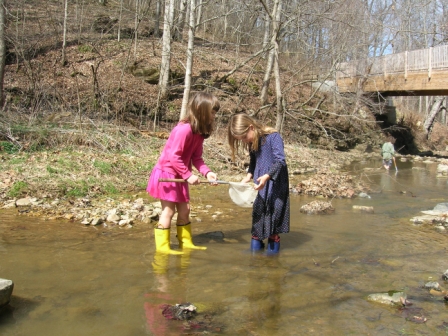 Connelly's Run. Named for
surveyor Connelly who laid out the Wilderness Road in advance of
Daniel Boone. But when you are talking about playing in a "small
body of running water," only creek will do. And when you hop
across stones or hunt crayfish in a creek, you call that creek
walking. . .
Connelly's Run. Named for
surveyor Connelly who laid out the Wilderness Road in advance of
Daniel Boone. But when you are talking about playing in a "small
body of running water," only creek will do. And when you hop
across stones or hunt crayfish in a creek, you call that creek
walking. . .
Holy Land
When
Sam was learning to walk, we ventured out in expanding
concentric circles. Eventually we journeyed beyond our backyard,
across the gravel alley, through a hemlock break, and into our
neighbor's yard. It had something bright and colorful that our
yard did not yet possess, a swing set. But next to the swing set
was an even better find, a green plastic sandbox in the shape of
a turtle. Sam squatted down to look insid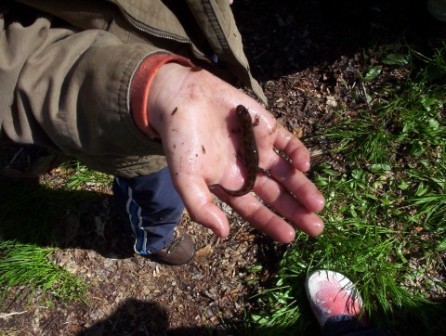 e,
and I helped him remove the bricks holding the lid down. Water
drained from algae-stained pools. The inside hadn't seen
daylight in a long time. . .
e,
and I helped him remove the bricks holding the lid down. Water
drained from algae-stained pools. The inside hadn't seen
daylight in a long time. . .
Bridge 33
It has
been a great summer for fishing. With a blood worm and a split
shot, seven-year-old Sam showed up the guys and their surf rigs
on the Virginia Beach pier and caught the largest flounder of
the day, its sixteen inches only half an inch under the limit.
And he beat all other fishermen one day at the lake in the
Poconos, including his grandfather, by landing a sixteen-inch
pickerel, the only non-panfish brought to shore. He also caught
the largest bass his cousins had seen in the pond across the
street from his uncle's house in Syracuse. Though it barely fit
in our white joint-compound bucket, we brought it up to the
house to show everyone, giving it a temporary home in the
galvanized tub that held last night's round of beers. . .
Field Guides
The
green, vinyl-covered North American Reptiles and Amphibians
published by the Audubon Society was probably the first,
followed closely by the yellow North American Butterflies.
Both are thumb-worn, their color plates pulling away from the
binding. We added them to those my wife and I already owned: the
brown North American Trees and the Field Guide to the
Birds of North America by the National Geographic Society.
They put out a good My First Pocket Guide series, and we have
some for mammals, reptiles, and fish. An older friend cleaning
out her bookshelves gave us the Golden Guide to pond life
and one for wildflowers, "full-color, easy-to-use," and we had
to get a Birds of the World when we lived in Europe. . .
Swimming Hole
I
began the summer with two simple goals: grow a garden and find a
place to swim, a place to cool down and clean up after hoeing
and weeding, a watery area to call our own, a swimming hole. We
live on the New River, one of the oldest rivers,
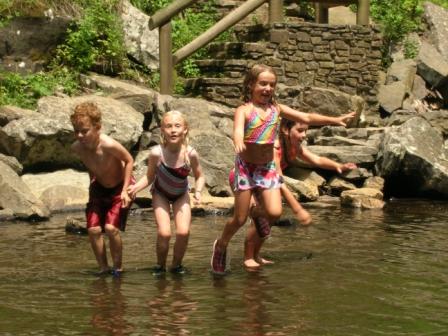 flowing north
out of the Carolina mountains and through Virginia on its way to
the Ohio. The New is the cleanest mainstem
river in Virginia by all accounts, but rarely will you see
people swimming in it. They mostly paddle and fish, sometimes
tube on this stretch, but few swimmers, people out swimming,
taking a leisurely and refreshing dip. . .
flowing north
out of the Carolina mountains and through Virginia on its way to
the Ohio. The New is the cleanest mainstem
river in Virginia by all accounts, but rarely will you see
people swimming in it. They mostly paddle and fish, sometimes
tube on this stretch, but few swimmers, people out swimming,
taking a leisurely and refreshing dip. . .
False Cape
"Ticks and biting insects are numerous, insect repellent and
sunscreen are a must. Beware, too, of eastern cottonmouths, a
poisonous snake also known as a water moccasin." I had been
warned by the website that camping was "not recommended for
young children or inexperienced campers," but we were
experienced, and why should young children be deprived of one of
the last undisturbed coastal environments on the East Coast? We
had been to the beach, to the Jersey Shore, and the Outer Banks,
but I had hoped for a camping and coastal experience outside of
an air-conditioned condo. . .
Tree House
Most
of the grounds on our lot have been explored,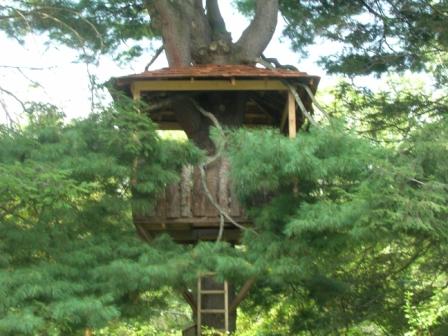 corner to corner, compost pile to fire pit, front yard and back.
Time to go up. We're going vertical, building a tree house, a
skyward play space, an aerial porch. . .
corner to corner, compost pile to fire pit, front yard and back.
Time to go up. We're going vertical, building a tree house, a
skyward play space, an aerial porch. . .
Seven Days
What
do you do when your seven-year-old son tells you he wants to
take a seven-day trip? I think he got the idea by reading about
buckskin explorers such as Lewis and Clark, but he had it fixed
in his mind that we would go, for seven days, me and him,
outside. We would fish and hike and camp, like they did a long
time ago. . .
Tide Pools
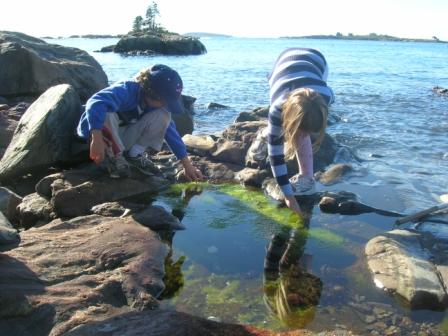 Consider
the life of an ordinary shell. It harbors and protects a soft
body within. It may come in different shapes and sizes, cone or
conch, scallop or clam. It may be discarded, washed up on shore,
ground down into sand unless recycled, when a new life may move
in, may itself move on like a hermit crab. . .
Consider
the life of an ordinary shell. It harbors and protects a soft
body within. It may come in different shapes and sizes, cone or
conch, scallop or clam. It may be discarded, washed up on shore,
ground down into sand unless recycled, when a new life may move
in, may itself move on like a hermit crab. . .
Dirt World
One
easy step toward getting kids out the door is to keep shoes
close. My kids are old enough now to go out on their own,
but if they can't find their shoes, they might not go. In fact,
if anything distracts them when we are making our way out, the
moment may have passed. One solution here is to emphasize that
they don't need shoes. Though I'm a hopeless tenderfoot, I still
love the feel of grass under my feet. But if it's cold out,
we've solved the problem of keeping shoes handy by building a
shoe shelf near the door. When we lived in Slovenia, we became
accustomed to slipping shoes off when we came inside. Slovenians
always have some kind of rack for holding outdoor shoes and
indoor slippers, and now we have one too. We also keep rain and
snow boots in a bench on the porch. Making it easy to slip on
the shoes makes it easy to slip out the door. . .

